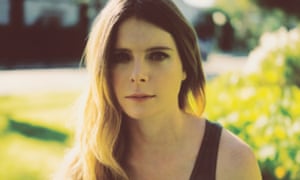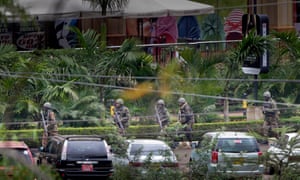 |
| ‘Working in the familiar mode of the big historical novel’ ... Yaa Gyasi Photograph: Cody Pickens/ |
The age of anxiety: what does Granta’s best young authors list say about America?
The US is in crisis - what about its literature? Michelle Dean reports on the list of American writers to watch this decade, which is as diverse as the country itself
Michelle Dean
Wednesday 26 April 2017 16.50 BST
I
t is a strange time to be making declarations about the nature of American writing. The country’s not exactly feeling well. And even before the events of last autumn, it used to be easier to know what people meant when they spoke of Great American Novels. They meant, chiefly, fat realist ones, usually authored by men. Philip Roth was the avatar of success in that model. He’d put America in the title, construct his characters around some kind of American archetype, and he was off and running.
Those markers of greatness are largely gone now. We live in an age of more fractured authority. In contemporary literary circles, Roth is reviled just as much as he is revered. Big fat novels by older white men are no longer in the ascendancy as they once were. For the last decade or so, the agitation has been to open up the forms and subjects considered serious, to let more women and people of colour into the canon. And if the third Granta list of the best young American novelists is evidence, that agitation has been successful. Judged by authors Patrick DeWitt, AM Homes, Kelly Link, Ben Marcus, and publisher Sigrid Rausing, the list turns out to have a majority of women writers (13 to nine men). It is also diverse.
The most striking thing about the list is how little its inhabitants might be said to have in common, as writers. Stylistically, they run the gamut, from a lyrical realist such as Emma Cline to an absurdist-complete-with-font-size changes such as Jesse Ball. We also have traditionally a “ambitious” novelist here, one who bit off a larger subject than he could chew: Garth Risk Hallberg, whose much-hyped City on Fire was a big tower of Babel kind of book. In Yaa Gyasi, too, we have someone working in the familiar mode of the big historical novel. But this list also contains several novelists whose ambitions are more directed at form: Lauren Groff, whose Fates and Furies had a few structural fireworks, and Ottessa Moshfegh, who is devoted to avoiding traditional forms of literary satisfaction for the reader, such as plot and character development. And we have Ben Lerner, whose work usually stands in for the closest thing American literature has right now to a bona fide trend: autofiction.
The list does not cover all the bases, of course. There are the usual confusing omissions. Téa Obreht is absent, perhaps a function of the long interlude since her first novel, The Tiger’s Wife, appeared in 2011. Another is Nathan Hill, whose The Nix was something of a sleeper hit last year. I’m surprised not to see Alexandra Kleeman’s spirited You Too Can Have a Body Like Mine here either. And while looking at those absences, one gets hung up on the age thing, too. The artificial cut-off of 40 eliminates Viet Thanh Nguyen, whose debut novel The Sympathizer won a Pulitzer prize last year. Nell Zink and Hanya Yanagihara are shut out too. If the point of these lists is to highlight the best work being done by new voices, “young” might not be the marker we’re looking for. “New” could be better.
Other than that, however, the list’s apparent lack of theme or consistency feels quite appropriate to the moment. These writers don’t group very easily into “schools”. There isn’t really an American literature at the moment, but rather American literatures. Most novelists are not explicitly reaching for “American” themes. Though the power and the strife of the country might be at the forefront of their minds, especially now, especially after November, I would be surprised if any novelist on this list thought of themselves as having articulated something about that big fractious concept known as “America”. The ambitions of writers now follow narrower channels, for both good and bad.
In the 1990s and in the early 2000s, it did seem as if writers were involved in connected projects, interested in common questions. Past residents of these lists were more obviously in conversation with each other and with the literature of the recent past. On the 1996 list, Jonathan Franzen and Jeffrey Eugenides were something like friends. On the 2007 list, Nicole Krauss and Jonathan Safran Foer were married. Most young writers now, by contrast, seem to be working out of carefully chosen, idiosyncratic foxholes. It’s not easy to draw a line from the work of Catherine Lacey (whose Nobody Is Ever Missing is beautiful and abstracted) to the work of Greg Jackson (whose Prodigals was an exercise in muscular realist prose). There is a subject or a conceit that is interesting or useful to them, and they go full bore at working it out. This perhaps allows them to create purer art, but there is less of a sense that it is useful or necessary to group them together.
Fair enough when you consider America’s like that too. There isn’t one America, or even the two people wanted to talk about after the election. There’s more like five or 10 or 20, or perhaps 20 million. The diversity of perspective, the unwillingness to generalise: those are good traits in countries as they are in art.
The problem, of course, for the American novelist, young or otherwise, is that their work now comes to us in the midst of one common denominator: their country has been through a nervous breakdown, and the prognosis is not quite clear yet. There are those writers who will insist that their art, being designed to survive the times they live in, will be untouched by the general chaos. But I find it very hard to imagine that there are so many literary novelists who are not still asking themselves, quietly, what it is they are supposed to do now, especially if they are among the “best”. It seems to impose an obligation, to offer what insight one can.
In Granta’s issue introducing its list, you can see a writer or two try to work that out directly. It has a sombre mood that seems to reflect the gravity of the geopolitical situation. Mark Doten, who wrote The Infernal (2015), does it with fiction, trying an absurd run-on sentence farce that, like most satire these days, seems like documentary. “Mr President,” a lackey informs the commander-in-chief, “we can get you into a bunker with full communication equipment and you can give your address there, you just can’t do it in a goddamn plastic blimp at the start of World War III.” It doesn’t quite hang together, but one suspects that Doten never meant for the piece to be a polished product, just a cri de coeur. As that, it works.
But people would like to hear more from writers on this subject, if only because the absurdity of the present situation in America has everyone scrambling to get a foothold somewhere. They might as well get it from art, and the literary arts have a way of coming at a big catastrophe in a clever way, something which sheds new light on a fraught subject. Sana Krasikov’s essay in Granta, on working in Nairobi’s Westgate Mall after a massacre, is one example. Although not present for the tragedy itself, she finds herself fantasising about the escape route she might have used that day. The voyeurism of the experience unnerves her, a bit. “Was it the torment of other experiences I was fascinated by, or the inescapability?” she writes.
Karan Mahajan, author of The Association of Small Bombs, takes terrorism as his subject too. He is more wry than philosophical in describing the (fictional) bombing of a literary reading in Delhi. “Midway through item number 2, most people were sorry they had attended this boring flattery-festival; most were dead by the time item number 3 began.” Dinaw Mengestu, whose paragraphs are masterpieces of pacing, contributes a tense story too, about a man who learns that his uncle has died under terrible circumstances.
Here, unlike in their past work, there was something stitching these writers together, something you could call anxiety. It is hard not to read that anxiety as related to the present. Perhaps crisis forces commonality of purpose on one another. There is no crisis in American writing, of course, but there is a kind of crisis in America, a worry that the centre is not going to hold. The promise most of these “young” writers hold is the ability to guide us through it, in bad times and good.





No comments:
Post a Comment